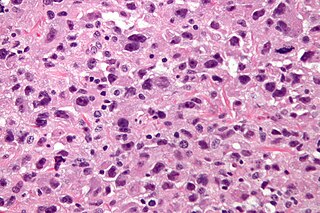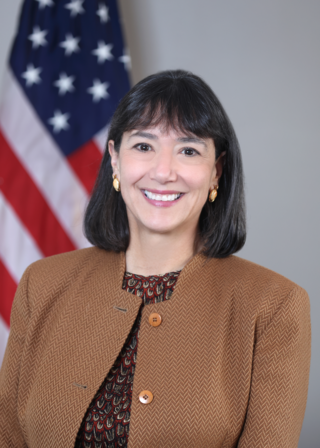Related Research Articles

A soft-tissue sarcoma (STS) is a malignant tumour, a type of cancer, that develops in soft tissue. A soft tissue sarcoma is often a painless mass that grows slowly over months or years. They may be superficial or deep-seated. Any such unexplained mass must be diagnosed by biopsy. Treatment may include, surgery, radiotherapy, chemotherapy, and targeted drug therapy. The other type of sarcoma is a bone sarcoma.

A sarcoma is a malignant tumor, a type of cancer that arises from transformed cells of mesenchymal origin. Connective tissue is a broad term that includes bone, cartilage, fat, vascular, or hematopoietic tissues, and sarcomas can arise in any of these types of tissues. As a result, there are many subtypes of sarcoma, which are classified based on the specific tissue and type of cell from which the tumor originates. Sarcomas are primary connective tissue tumors, meaning that they arise in connective tissues. This is in contrast to secondary connective tissue tumors, which occur when a cancer from elsewhere in the body spreads to the connective tissue. The word sarcoma is derived from the Greek σάρκωμα sarkōma "fleshy excrescence or substance", itself from σάρξsarx meaning "flesh".

Angiosarcoma is a rare and aggressive cancer that starts in the endothelial cells that line the walls of blood vessels or lymphatic vessels. Since they are made from vascular lining, they can appear anywhere and at any age, but older people are more commonly affected, and the skin is the most affected area, with approximately 60% of cases being cutaneous. Specifically, the scalp makes up ~50% of angiosarcoma cases, but this is still <0.1% of all head and neck tumors. Since angiosarcoma is an umbrella term for many types of tumor that vary greatly in origin and location, many symptoms may occur, from completely asymptomatic to non-specific symptoms like skin lesions, ulceration, shortness of breath and abdominal pain. Multiple-organ involvement at time of diagnosis is common and makes it difficult to ascertain origin and how to treat it.

Leiomyosarcoma is a malignant (cancerous) smooth muscle tumor. A benign tumor originating from the same tissue is termed leiomyoma. While leiomyosarcomas are not thought to arise from leiomyomas, some leiomyoma variants' classification is evolving.
The Children's Oncology Group (COG), a clinical trials group supported by the National Cancer Institute (NCI), is the world's largest organization devoted exclusively to pediatric cancer research. The COG conducts a spectrum of clinical research and translational research trials for infants, children, adolescents, and young adults with cancer.

Undifferentiated pleomorphic sarcoma (UPS), also termed pleomorphic myofibrosarcoma, high-grade myofibroblastic sarcoma, and high-grade myofibrosarcoma, is characterized by the World Health Organization (WHO), 2020, as a rare, poorly differentiated neoplasm, i.e. an abnormal growth of cells that have an unclear identity and/or cell of origin. WHO classified it as one of the undifferentiated/unclassified sarcomas in the category of tumors of uncertain differentiation. Sarcomas are cancers known or thought to derive from mesenchymal stem cells that typically develop in bone, muscle, fat, blood vessels, lymphatic vessels, tendons, and ligaments. More than 70 sarcoma subtypes have been described. The UPS subtype of these sarcomas consists of tumor cells that are poorly differentiated and may appear as spindle-shaped cells, histiocytes, and giant cells. UPS is considered a diagnosis that defies formal sub-classification after thorough histologic, immunohistochemical, and ultrastructural examinations fail to identify the type of cells involved.

Ewing sarcoma is a type of cancer that forms in bone or soft tissue. Symptoms may include swelling and pain at the site of the tumor, fever, and a bone fracture. The most common areas where it begins are the legs, pelvis, and chest wall. In about 25% of cases, the cancer has already spread to other parts of the body at the time of diagnosis. Complications may include a pleural effusion or paraplegia.

Epithelioid sarcoma is a rare soft tissue sarcoma arising from mesenchymal tissue and characterized by epithelioid-like features. It accounts for less than 1% of all soft tissue sarcomas. It was first clearly characterized by F.M. Enzinger in 1970. It commonly presents itself in the distal limbs of young adults as a small, soft mass or a series of bumps. A proximal version has also been described, frequently occurring in the upper extremities. Rare cases have been reported in the pelvis, vulva, penis, and spine.

Evofosfamide is an investigational hypoxia-activated prodrug that is in clinical development for cancer treatment. The prodrug is activated only at very low levels of oxygen (hypoxia). Such levels are common in human solid tumors, a phenomenon known as tumor hypoxia.
Cixutumumab (IMC-A12) is a human monoclonal antibody for the treatment of solid tumors.

A radiosensitizer is an agent that makes tumor cells more sensitive to radiation therapy. It is sometimes also known as a radiation sensitizer or radio-enhancer.

Follicular dendritic cell sarcoma (FDCS) is an extremely rare neoplasm. While the existence of FDC tumors was predicted by Lennert in 1978, the tumor wasn't fully recognized as its own cancer until 1986 after characterization by Monda et al. It accounts for only 0.4% of soft tissue sarcomas, but has significant recurrent and metastatic potential and is considered an intermediate grade malignancy. The major hurdle in treating FDCS has been misdiagnosis. It is a newly characterized cancer, and because of its similarities in presentation and markers to lymphoma, both Hodgkin and Non-Hodgkin subtypes, diagnosis of FDCS can be difficult. With recent advancements in cancer biology better diagnostic assays and chemotherapeutic agents have been made to more accurately diagnose and treat FDCS.

Nanobiotix is a biotechnology company that uses nanomedicine to develop new radiotherapy techniques for cancer patients. The company is headquartered in Paris, with additional corporate offices in New York and Massachusetts.
George Bosl is an American cancer researcher, holder of the Patrick M. Byrne Chair in Clinical Oncology at the Memorial Sloan-Kettering Cancer Center in New York City, and is a professor of medicine at the Weill Cornell Medical College. In 1997, he was appointed chair of the Department of Medicine at Sloan-Kettering, a position which he held until 2015. In 2019, he was named Memorial Sloan Kettering's first ombudsperson.
John H. Healey is an American cancer surgeon, researcher, and expert in the surgical treatment of benign and malignant bone tumors and other musculoskeletal cancers. He serves as Chair of the Orthopaedic Service and Stephen P. McDermott Chair in Surgery at Memorial Sloan-Kettering Cancer Center (MSKCC), as well as Professor of Surgery at Weill Cornell Medical College, in New York, NY.

Patrick Schöffski is a German medical doctor specializing in internal medicine, hematology and medical oncology.

Roland Mertelsmann is a German hematologist and oncologist. He was a professor at the Freiburg University Medical Center, Department of Internal Medicine I (Oncology/Hematology). Mertelsmann is known for his scientific works in the fields of hematology, oncology, gene therapy and stem cell transplantation.
Roy S. Herbst is an American oncologist who is the Ensign Professor of Medicine, Professor of Pharmacology, Chief of Medical Oncology, and Associate Director for Translational Research at Yale Cancer Center and Yale School of Medicine in New Haven, Connecticut.

Monica Bertagnolli is an American surgical oncologist and the 16th director of the National Cancer Institute. Previously, she worked at Brigham and Women's Hospital and Dana–Farber Cancer Institute and was the Richard E. Wilson Professor of Surgery at Harvard Medical School. She has advocated for inclusion of rural communities in clinical studies and served as Chair of the Alliance for Clinical Trials in Oncology until her appointment to lead NCI. Bertagnolli specializes in the treatment of tumors from gastrointestinal diseases and soft tissue sarcomas. She is the former President of the American Society of Clinical Oncology and was elected Fellow of the National Academy of Medicine in 2021.
Gardner fibroma (GF) is a benign fibroblastic tumor. GF tumors typically develop in the dermis and adjacent subcutaneous tissue lying just below the dermis. These tumors typically occur on the back, abdomen, and other superficial sites but in rare cases have been diagnoses in internal sites such as the retroperitoneum and around the large blood vessels in the upper thoracic cavity. The World Health Organization, 2020, classified Gardner fibroma as a benign tumor in the category of fibroblastic and myofibroblastic tumors.
References
- ↑ "Robert Maki Moves to Leadership Role at Northwell Health Cancer Institute". Targeted Oncology. Retrieved 17 July 2018.
- ↑ "CSHL Investigator Profile". cshl.edu. Retrieved 25 July 2018.
- ↑ "ISP landing page". ISP home page. Retrieved 25 July 2018.
- ↑ "CUGSMS". Cornell Med Grad Landing page. Retrieved 25 July 2018.
- ↑ "CUMC landing page". Cornell med web site. Retrieved 25 July 2018.
- ↑ "PKS UConn site". UConn Srivastava. Retrieved 25 July 2018.
- ↑ Maki, Robert; et al. (2007). "Randomized phase II study of gemcitabine and docetaxel compared with gemcitabine alone in patients with metastatic soft tissue sarcomas". J Clin Oncol. 25 (24): 2755–2763. doi:10.1200/JCO.2006.10.4117. PMID 17602081.
- ↑ "SARC landing page". SARC. Retrieved 25 July 2018.
- ↑ Maki, Robert; et al. (1990). "Human homologue of murine tumor rejection antigen gp96". Proc Natl Acad Sci USA. 87 (15): 5658–5662. doi: 10.1073/pnas.87.15.5658 . PMC 54386 . PMID 2377606.
- ↑ Srivastava, Pramod; Maki, Robert (1991). "Stress induced proteins in immune response to cancer". Curr Top Microbiol Immunol. Current Topics in Microbiology and Immunology. 167: 109–123. doi:10.1007/978-3-642-75875-1_7. ISBN 978-3-642-75877-5. PMID 1711433.
- ↑ Italiano, Antoine; et al. (2012). "High prevalence of CIC fusion with double homeobox (DUX4) transcription factors in EWSR1-negative undifferentiated small round blue cell sarcomas". Genes Chromosomes Cancer. 51 (3): 207–218. doi:10.1002/gcc.20945. PMC 3404826 . PMID 22072439.
- ↑ Matushansky, Igor; et al. (2007). "Derivation of sarcomas from mesenchymal stem cells via inactivation of the Wnt pathway". J Clin Invest. 117 (11): 3248–3257. doi:10.1172/JCI31377. PMC 2030456 . PMID 17948129.
- ↑ Han, Dan; et al. (2017). "Targeting sarcoma tumor-initiating cells through differentiation therapy". Stem Cell Res. 21: 117–123. doi:10.1016/j.scr.2017.04.004. PMC 5988213 . PMID 28433655.
- ↑ Carbini, Mariana; et al. (2018). "A method to summarize toxicity in cancer randomized clinical trials". Clin Cancer Res. 24 (20): 4968–4975. doi: 10.1158/1078-0432.CCR-17-3314 . PMID 29739789.
- ↑ Brennan, Murray; Antonescu, Cristina; Alektiar, Kaled; Maki, Robert (2016). Management of Soft Tissue Sarcoma (2nd ed.). Springer. p. 399. ISBN 978-3-319-41904-6.
- ↑ "MCCR". MCCR landing page. Retrieved 25 July 2018.